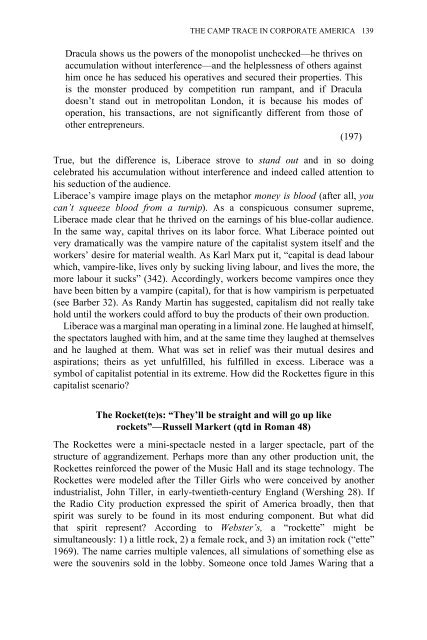Edited by Moe Meyer - Get a Free Blog
Edited by Moe Meyer - Get a Free Blog
Edited by Moe Meyer - Get a Free Blog
You also want an ePaper? Increase the reach of your titles
YUMPU automatically turns print PDFs into web optimized ePapers that Google loves.
THE CAMP TRACE IN CORPORATE AMERICA 139<br />
Dracula shows us the powers of the monopolist unchecked—he thrives on<br />
accumulation without interference—and the helplessness of others against<br />
him once he has seduced his operatives and secured their properties. This<br />
is the monster produced <strong>by</strong> competition run rampant, and if Dracula<br />
doesn’t stand out in metropolitan London, it is because his modes of<br />
operation, his transactions, are not significantly different from those of<br />
other entrepreneurs.<br />
(197)<br />
True, but the difference is, Liberace strove to stand out and in so doing<br />
celebrated his accumulation without interference and indeed called attention to<br />
his seduction of the audience.<br />
Liberace’s vampire image plays on the metaphor money is blood (after all, you<br />
can’t squeeze blood from a turnip). As a conspicuous consumer supreme,<br />
Liberace made clear that he thrived on the earnings of his blue-collar audience.<br />
In the same way, capital thrives on its labor force. What Liberace pointed out<br />
very dramatically was the vampire nature of the capitalist system itself and the<br />
workers’ desire for material wealth. As Karl Marx put it, “capital is dead labour<br />
which, vampire-like, lives only <strong>by</strong> sucking living labour, and lives the more, the<br />
more labour it sucks” (342). Accordingly, workers become vampires once they<br />
have been bitten <strong>by</strong> a vampire (capital), for that is how vampirism is perpetuated<br />
(see Barber 32). As Randy Martin has suggested, capitalism did not really take<br />
hold until the workers could afford to buy the products of their own production.<br />
Liberace was a marginal man operating in a liminal zone. He laughed at himself,<br />
the spectators laughed with him, and at the same time they laughed at themselves<br />
and he laughed at them. What was set in relief was their mutual desires and<br />
aspirations; theirs as yet unfulfilled, his fulfilled in excess. Liberace was a<br />
symbol of capitalist potential in its extreme. How did the Rockettes figure in this<br />
capitalist scenario?<br />
The Rocket(te)s: “They’ll be straight and will go up like<br />
rockets”—Russell Markert (qtd in Roman 48)<br />
The Rockettes were a mini-spectacle nested in a larger spectacle, part of the<br />
structure of aggrandizement. Perhaps more than any other production unit, the<br />
Rockettes reinforced the power of the Music Hall and its stage technology. The<br />
Rockettes were modeled after the Tiller Girls who were conceived <strong>by</strong> another<br />
industrialist, John Tiller, in early-twentieth-century England (Wershing 28). If<br />
the Radio City production expressed the spirit of America broadly, then that<br />
spirit was surely to be found in its most enduring component. But what did<br />
that spirit represent? According to Webster’s, a “rockette” might be<br />
simultaneously: 1) a little rock, 2) a female rock, and 3) an imitation rock (“ette”<br />
1969). The name carries multiple valences, all simulations of something else as<br />
were the souvenirs sold in the lob<strong>by</strong>. Someone once told James Waring that a


